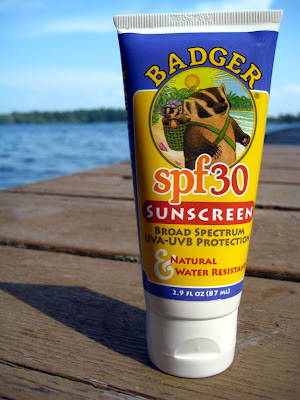I am a sun worshiper. Basking in the hot afternoon rays of summer is by far my guiltiest pleasure, and a joy I am not about to relinquish anytime soon. Yes, I am well aware of the dangers of sun damage, and the potential of cancer, but since making the move to a more holistic and natural lifestyle, I have begun to question whether or not my sunscreen is doing more harm than good.
When the president of the American Academy of Dermatology says, “Sunscreens are an essential weapon in the fight against skin cancer,” it’s a daunting undertaking to suggest alternative thinking. It may seem like second nature to you to apply sunscreen before going out in the sun, as the media has been bombarding us with reports of the dangers of the sun for some time now. Sun block has been added to many common skin care products like face and body moisturizer, bug repellent, even makeup! Kids versions have been made and exciting with bright coloured lotions, sprays and fragrances.
But the issue here is whether sunbathing without sunscreen enhances one’s health or undermines it. The overriding mantra of any dermatologist would be that the sun is the main culprit behind skin cancers and malignant melanomas. The incidence of these cancers has risen dramatically in the last two or three decades, in US there are 54,000 cases annually, during which time the use of potent UVB-blocking sunscreens has also skyrocketed. There must be a correlation between these two factors, or at least they are not correlating, leading many scientists to rethink the sun block theory.
How Sunscreen Works
Sunscreen works by combining organic and inorganic active ingredients. Inorganic ingredients like zinc oxide or titanium oxide reflect or scatter ultraviolet (UV) radiation. Organic ingredients like oxybenzone absorb UV radiation, dissipating it as heat.
When purchasing sunscreen, the Sun Protection Factor or SPF measures how effectively the sunscreen formula limits skin exposure to UV-B rays that burn the skin. The higher the SPF the more protection the sunscreen will provide. For example, SPF 15 sunscreen allows a person to stay out in the sun 15 times longer than they could w/o sunscreen, so someone who burns in 10 minutes could be out for 150 minutes w/o burning. SPF does not measure UV-A. If you are looking for UV-A protection, the experts recommend that you purchase a product that has broad-spectrum protection.
3 Reasons Why Sunscreen Isn’t Awesome
1.Sunscreen ingredients are powerful free radical generators that increase cellular damage and changes that lead to cancer.
Avobenzone is a powerful free radical generator that is easily absorbed through the epidermis and is still a chemical that absorbs ultraviolet radiation energy. Since it cannot destroy this energy, it has to convert the light energy into chemical energy, which is normally released as free radicals. It is used in sunscreen to block long-wave UVA making a “broad-spectrum” sun block. It does not effectively UVB or short-wave UVA radiation so this ingredient is combined with organic compounds to produce a typical commercial sun block. In sunlight, avobenzone degrades and becomes ineffective within about 1 hour.
2. Sunscreen ingredients can have strong estrogenic activity.
Even worse for your health is the fact that many common free radical generating sunscreen chemicals also have estrogen like-effects. Estrogenic chemicals can mimic hormonal (or real) estrogen, the key female sex hormone. When the body’s hormone receptors recognize the estrogenic chemical as estrogen, the result is feminization of the tissue. Such effects can increase cancers, cause birth defects in children, lower sperm counts and penis size in men, diminish libido, plus a plethora of other medical problems. These effects are similar to many banned chemicals such as DDT, Dioxin, and PCBs.
3. Sunscreen Blocks Vitamin D Production
The other major problem with sunscreen, aside from the potential chemical toxicity, is that it blocks your skin’s ability to make vitamin D by more than 95 percent. The major biologic function of vitamin D is to maintain normal blood levels of calcium and phosphorus. Vitamin D aids in the absorption of calcium, helping to form and maintain strong bones. It promotes bone mineralization in concert with a number of other vitamins, minerals, and hormones. It has also been associated with improvement of the following conditions: diabetes, heart dihttp://www.blogger.com/img/gl.link.gifsease, arthritis, infertility and PMS, Autoimmune disorders, fatigue, depression and seasonal affective disorder. Regular sun exposure is the best way to obtain the recommended amount of Vitamin D. The best place to get vitamin D is from UV-B from sunlight. For fair-skinned people it only takes about 20 minutes of sun exposure on your hands and face to achieve the Recommended Daily Allowance (RDA).
This does not mean that we should all go out and get as much sun as we want. We all must exercise caution and avoiding a burn is key. Sunburn is a sign of serious skin damage and is very different from a tan in terms of health.
Our Prayers Have Been Answered
A friend passed on a website to me that I have become totally addicted to: Skin Deep: Cosmetic Safety Database. You can type in almost any personal care product and it will rate it on a scale from 1 to 10 depending on its toxicity level. The first thing I looked up was sunscreen, as I have had my fair share of burns after a long day on the dock and needed to find a compromise. Badger Sunscreen, a product I had never heard of, registered as a zero, the lowest rating of toxicity, so of course I made a bee line for the health food store to pick up several tubes. Badger is an American company that makes a line of skin care products from all-natural, organic ingredients. I have been performing several “scientific tests” at my cottage over the past few weekends and I can attest that it is totally effective, despite its list of pronounceable ingredients. It also smells amazing thanks to its lavender essential oil. Now, truth be told, natural sun blocks do just that: they block the sun, literally. I have discovered with the SPF 30, the zinc levels are so high, that your skin turns a slight bluish-white tinge unless you rub it in very well. I’d rather look like a mime than a lobster anyway.
You can buy this product on line from the Badger website, or pick up a tube at your local health food store. Keep in mind that because the quality of this product is so high, the price reflects this. The SPF 15 formula retails for about $15 and the SPF 30, about $16. Some things you just can’t put a price on, and for me, there’s no question. A sun block that does more good than harm? Slather it on, and let the sun shine in!
And since I wrote this blog post 10 years ago, I’ve fallen in love with Living Libations’ sun products. The beach balm with zinc as well as the Everybody Loves the Sunshine, are two of my favourite ways to celebrate the sun. Use: mynewroots15 for 15% off!



I have just got a new job which is outdoors 7-5 mostly sailing with a tremendous amount of sun exposure and have been guiltily lathering myself in sunscreen with worries about various things I have read but this has made me feel much better now I’ve got some Badger on the way! Many Thanks
What do you use for an everyday facial moisturizer? I’m trying to get rid of my chemical-laden ‘beauty’ supplies….
I like your article and it really gives an outstanding idea that is very helpful for all the people on web.